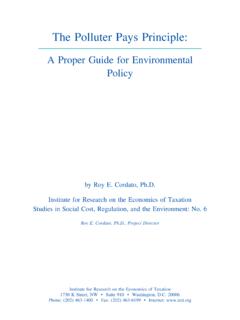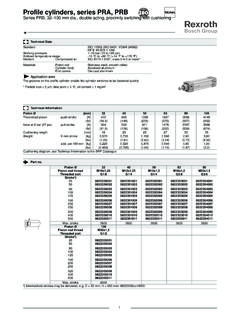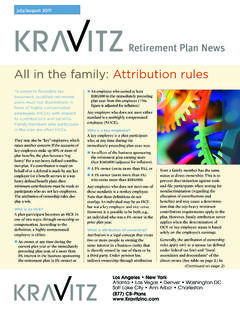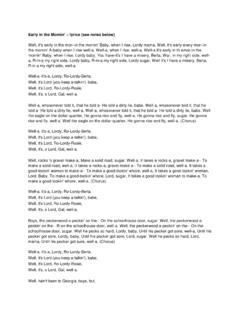Transcription of THE TAX SYSTEM OF CHINA - IRET
1 December 23, 2010. No. 94. THE TAX SYSTEM OF CHINA . Introduction and Summary The People's Republic of CHINA (PRC) has transformed its tax SYSTEM in recent years. It has adopted many types of taxes common in major nations with large private sectors that engage actively in world trade. CHINA seeks an appropriate balance between revenue raising, fairness, and growth- permitting types and levels of taxes. Growth is an important goal, because raising living standards can benefit everyone. The central government relies chiefly on a value added tax for its revenue. The VAT is one of several types of consumption-based tax in which investment in plant and equipment is expensed immediately, not depreciated over time.
2 Consumption-based taxes are less damaging to saving and investment than traditional income taxes. The corporate income tax rate is 25 percent, close to the average for developed nations and well below the rates in the United States and Japan. The provinces are allowed individual and business income taxes, but their structure is determined by the central government, and contain several provisions that are friendly to saving and investment. To avoid multiple layers of taxation on saving and returns on saving: ! Capital gains on stock trades are tax exempt. ! Half of dividends from companies listed on Chinese stock exchanges are tax exempt. ! Bank deposit and government bond interest are tax exempt.
3 ! Foreign investors are free from tax on capital gains and dividends. ! At present, there is no estate or transfer tax. ! Social insurance contributions are tax deductible and social insurance benefits are tax free. Rural workers own their social insurance accounts, as in many countries that have private accounts for social insurance rather than centralized tax/transfer programs. In short, CHINA has a tax SYSTEM that relies relatively heavily on consumption taxes, and its individual income tax is structured to avoid or reduce the excess layers of tax on saving and investment usually found in income tax systems. Institute for IRET is a non-profit, tax exempt 501(c)3 economic policy research and educational organization devoted to informing the public about policies that will promote Research economic growth and efficient operation of the market economy.
4 On the Economics of 1710 Rhode Island Avenue, , 11th Floor Washington, 20036. Taxation (202) 463-1400 Fax (202) 463-6199 Internet Page 2. General Government Taxes Taxes are collected for the general operations of the national, provincial, and local governments. ( CHINA defines general operations to exclude social insurance programs.) According to 2007 data from the State Administration of Taxation1, total government tax revenues (excluding social insurance taxes) were RMB 4, billion. This was equivalent to US$ , at the average 2007. exchange rate of RMB per Approximately 70 percent went to the central government, while the rest was reserved for the provincial and local governments.
5 The 4, billion RMB. equaled percent of CHINA 's (The corresponding 2007 figure for general government taxes in the United States was percent of GDP.). The Chinese tax SYSTEM is a mix of consumption, income, property, and other taxes. In 2007, percent of CHINA 's total tax revenue (net of export tax rebate) came from consumption taxes, which consisted of a VAT (net of export rebate), business sales taxes and other consumption taxes;. percent came from income taxes; percent came from various property taxes and taxes related to property investment; and the rest came from other forms of taxes. Compared to the percent of federal, state, and local general government tax revenues contributed by income taxes in the United States, it is clear that CHINA 's tax SYSTEM has relatively heavy reliance on consumption taxes, while income taxes come in second place, and various property taxes come next.
6 Tax legislative power in CHINA is highly Local governments only have the right to abandon the banquet and slaughter taxes as well as changing tax rates for a few minor taxes (city maintenance and construction tax, vehicle and vessel usage tax, house property tax, etc.) for certain social groups (disabled people, the elderly, minorities, etc.) or/and under certain conditions (natural disasters, etc.)5 The local tax administrations have no legislative power on major tax rates and external taxation. As a consequence, there exists limited scope for competition among provinces in the use of tax policies to attract investment. The central government has tried to spread the successful experience of special coastal economic zones throughout the country by gradually spreading the more favorable tax treatment of investment nationwide, reducing regional disparities.
7 1. Unless specified, all data on CHINA 's tax rates in this paper, excluding social insurance contribution rates, are retrieved from the Online Tax Code Library of State Administration of Taxation, PRC: 2. For exchange rate data, see Council of Economic Advisers, Economic Report Of The President (Washington, DC: Government Printing Office, 2008), p. 352. 3. Unless specified, all data on CHINA 's tax revenue and national GDP in this paper are retrieved from annual bulletin released by CHINA National Bureau of Statistics of CHINA : 4. State Council, PRC, Guofa [1993] No. 85, Dec. 15, 1993. 5. State Council, PRC, Guofa [1994] , Jan. 23, 1994. Page 3. However, additional preferential tax policies legislated by the central government have been implemented in relatively underdeveloped regions in west and northeast CHINA in order to speed development in the poorer areas.
8 The recent unification of tax treatment of domestic and foreign enterprises (described below) also contributes to a more uniform tax structure in CHINA . Social Insurance Taxes and Contributions In CHINA , the social insurance program is separate from the general taxation SYSTEM . Government employees and workers in the state-run institutions such as schools and hospitals have a separate retirement program. Currently, the social insurance program is supposed to cover most non-government urban employees, retirees, and some of the rural labor force. However, in 2007, only 76 percent of the urban non-government employees and less than 10 percent of the rural labor force were covered by the basic pension fund The other social insurance plans, such as medical care and unemployment and work injury insurance, have even lower participation rates.
9 This indicates that further expansion of social insurance coverage remains to be achieved. The retirement program for rural workers consists of personal, tax-deductible retirement savings accounts at banks, to which a worker may contribute up to RMB 20 per month (equivalent to US$ ). These contributions are not properly called taxes, because the rural workers own their accounts and get back the earnings of their own savings when they retire. An unusual feature of the retirement saving incentive is that the withdrawals from the accounts after retirement are also tax exempt. This is more generous than ordinary pension treatment of saving, in that neither the contribution nor the withdrawal is taxable income.
10 Social insurance contributions of the urban employees are more properly viewed as taxes, because the workers do not own the accounts (except for a modest portion, about 8%), and there is only a limited relationship between the amount of taxes that they pay and the benefits they receive later. The benefits are set by law and can be changed by the local government. The tax can be collected through either local taxation departments or the labor and social security authority. Total social insurance contributions by both urban employers and employees in 2007 were RMB billion (equivalent to US$ billion). The social insurance tax rates in CHINA are higher than in the United States and closer to those of the European nations.










